The Patent Office
by Elton Gish
Reprinted from "Crown Jewels of the Wire", July 1991, page 22
GEORGE W. KIDWELL INSULATOR
Patent No. 120,884 dated Nov. 14, 1871
A new two-part glass telegraph insulator has been found! It was discovered by
the American Resources Group, Ltd. in Salem, Illinois while performing
archaeological work for the Illinois State Museum. As you can see in the
photographs, the glass insulator is not a pin-type, but rather a cylindrical
insulator.
The insulator was found at an excavation site near an old tavern on
the St. Louis-Vincennes Trace paralleling the Ohio and Mississippi railroad.
This broad-gauge railroad was completed in 1855 between Illinoistown and
Vincennes. It is now part of the Baltimore & Ohio System. In 1857, the
entire line from St. Louis to Cincinnati was completed. The cylindrical glass telegraph insulator was found about one foot below the surface in
the remains of a shallow privy used by travelers at the local tavern. Other
artifacts were found in the privy such as broken earthenware, glass bottles and
flasks, a fork, and several buttons. This shallow privy was typical in that area
near public buildings. The shallow depth allowed chickens easy access to
undigested items in the waste.
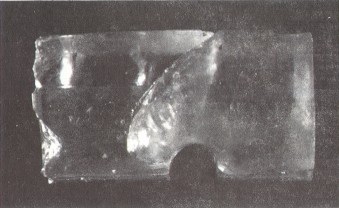
Now for a description of the insulator: The glass
is a light aqua color measuring 2-1/2 inches, long with a diameter of 1-5/8
inches. There is a central channel or groove 3/4 inches in diameter. There is an
additional groove on the exterior surface that runs perpendicular to the length. This groove is approximately 7/16 inches in diameter. One end of the
insulator has a flat surface and the other end a concave surface slightly
tapering inward toward the wire groove (central channel).
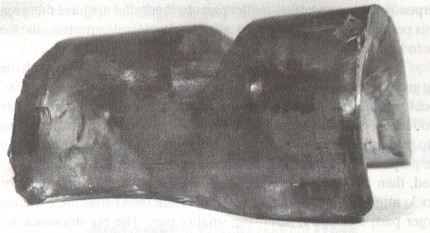
The insulator was
manufactured based on the utility improvement claims of patent number 120,884
granted to George W. Kidwell on November 14, 1871. As you can see from the
patent drawing, this insulator was originally intended to consist of two parts
of equal size, together making a complete cylinder. It is common for actual
production to vary considerably from the patent. This could be due to
manufacturing problems or simply a better, more practical application by
changing the patent design slightly.
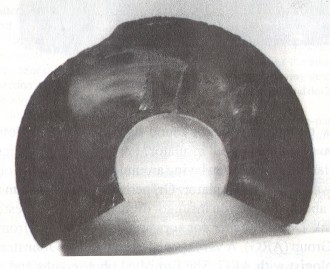
The specimen is not one-half of a cylinder, but rather about 2/3 of a
cylinder. This may have allowed easier placement of the telegraph wire in the
larger part and easier insertion of the second smaller (1/3 of a cylinder) part.
Also, it could have allowed the lineman to easily recognize which part had the perpendicular groove [the smaller part obviously did not have this groove].
This perpendicular groove received a wooden dowel permitting the insulator to be
secured in the wooden block.
One claim in the patent was a semicircular
projection with matching groove near one end that would not allow the two parts
to slip apart. This specimen did not have this feature. With such a matching
projection and groove, the two parts would be put together around the wire, then
inserted into the wooden block. However, this would not allow the lineman to
align the perpendicular groove with the wooden dowel. If this feature was not
used, then the lineman could first insert the larger part into the wooden block,
align this part with the wooden dowel, then insert the wire into the larger
part, and lastly, insert the smaller part. The big drawback to this design is
that the smaller glass part would eventually slip out and fall to the ground.
The telegraph wire would be unsecured inside the hole in the wooden block, and,
eventually, the larger glass part would fall out, too.
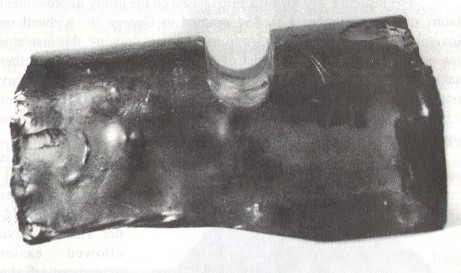
I wonder how this glass insulator found its way into a shallow privy? Have
any of you seen this Kidwell insulator? Perhaps one of you has a "piece of
glass" similar to this specimen laying around, but, until now, you were
unaware that it was in fact an insulator. Or, perhaps you have found the missing
1/3!? How about some of you insulator diggers in the mid-west?
I want to thank
Dennis Weber for forwarding the request from American Resources Group (ARG). A
very special thanks to Jane Johnston who is a staff archaeologist with ARG. She
furnished photographs and a history, information about the location and details
of the excavation, and generously arranged with the Illinois State Museum for me to borrow the
insulator in time to take it to the Portland National.
If any of you
have a patent question, please do not hesitate to ask. I now have copies of 1049
insulator patents and 36 design patents. Copies for any of these patents are
available from me for $1.00 each.
Elton Gish, P.O. Box 1317, Buna, Texas 77612
(409) 994-5662
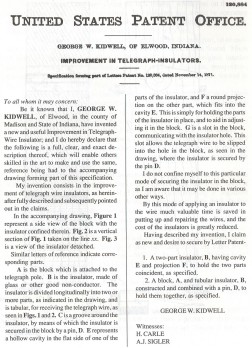
Medium Image (141 Kb)
Large Image (270 Kb)
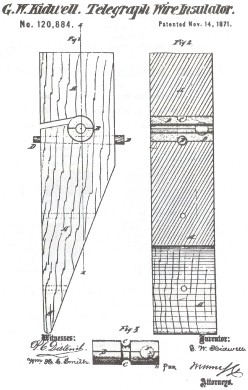
Medium Image (103 Kb)
Large Image (197 Kb)
| 